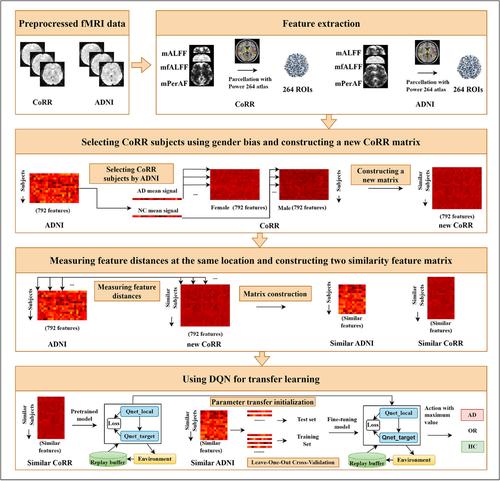当前位置:
X-MOL 学术
›
Eur. J. Nerosci.
›
论文详情
Our official English website, www.x-mol.net, welcomes your feedback! (Note: you will need to create a separate account there.)
Classification of Alzheimer's disease: application of a transfer learning deep Q-network method
European Journal of Neroscience ( IF 3.4 ) Pub Date : 2024-01-28 , DOI: 10.1111/ejn.16261 Huibin Ma 1, 2 , Yadan Wang 1, 2 , Zeqi Hao 3 , Yang Yu 4 , Xize Jia 5 , Mengting Li 3 , Lanfen Chen 6
European Journal of Neroscience ( IF 3.4 ) Pub Date : 2024-01-28 , DOI: 10.1111/ejn.16261 Huibin Ma 1, 2 , Yadan Wang 1, 2 , Zeqi Hao 3 , Yang Yu 4 , Xize Jia 5 , Mengting Li 3 , Lanfen Chen 6
Affiliation

|
Early diagnosis is crucial to slowing the progression of Alzheimer's disease (AD), so it is urgent to find an effective diagnostic method for AD. This study intended to investigate whether the transfer learning approach of deep Q-network (DQN) could effectively distinguish AD patients using local metrics of resting-state functional magnetic resonance imaging (rs-fMRI) as features. This study included 1310 subjects from the Consortium for Reliability and Reproducibility (CoRR) and 50 subjects from the Alzheimer's Disease Neuroimaging Initiative (ADNI) GO/2. The amplitude of low-frequency fluctuation (ALFF), fractional ALFF (fALFF) and percent amplitude of fluctuation (PerAF) were extracted as features using the Power 264 atlas. Based on gender bias in AD, we searched for transferable similar parts between the CoRR feature matrix and the ADNI feature matrix, resulting in the CoRR similar feature matrix served as the source domain and the ADNI similar feature matrix served as the target domain. A DQN classifier was pre-trained in the source domain and transferred to the target domain. Finally, the transferred DQN classifier was used to classify AD and healthy controls (HC). A permutation test was performed. The DQN transfer learning achieved a classification accuracy of 86.66% (p < 0.01), recall of 83.33% and precision of 83.33%. The findings suggested that the transfer learning approach using DQN could be an effective way to distinguish AD from HC. It also revealed the potential value of local brain activity in AD clinical diagnosis.
中文翻译:

阿尔茨海默病的分类:迁移学习深度 Q 网络方法的应用
早期诊断对于减缓阿尔茨海默病(AD)的进展至关重要,因此迫切需要找到有效的AD诊断方法。本研究旨在探讨深度 Q 网络 (DQN) 的迁移学习方法是否可以使用静息态功能磁共振成像 (rs-fMRI) 的局部指标作为特征来有效区分 AD 患者。这项研究包括来自可靠性和再现性联盟 (CoRR) 的 1310 名受试者以及来自阿尔茨海默病神经影像倡议 (ADNI) GO/2 的 50 名受试者。使用 Power 264 图集提取低频波动幅度 (ALFF)、分数 ALFF (fALFF) 和波动百分比幅度 (PerAF) 作为特征。基于AD中的性别偏见,我们在CoRR特征矩阵和ADNI特征矩阵之间搜索可转移的相似部分,得到CoRR相似特征矩阵作为源域,ADNI相似特征矩阵作为目标域。 DQN 分类器在源域中进行预训练并转移到目标域。最后,使用转移的 DQN 分类器对 AD 和健康对照 (HC) 进行分类。进行了排列测试。 DQN 迁移学习的分类准确率为 86.66% ( p < 0.01),召回率为 83.33%,准确率为 83.33%。研究结果表明,使用 DQN 的迁移学习方法可能是区分 AD 和 HC 的有效方法。它还揭示了局部大脑活动在AD临床诊断中的潜在价值。
更新日期:2024-01-28
中文翻译:

阿尔茨海默病的分类:迁移学习深度 Q 网络方法的应用
早期诊断对于减缓阿尔茨海默病(AD)的进展至关重要,因此迫切需要找到有效的AD诊断方法。本研究旨在探讨深度 Q 网络 (DQN) 的迁移学习方法是否可以使用静息态功能磁共振成像 (rs-fMRI) 的局部指标作为特征来有效区分 AD 患者。这项研究包括来自可靠性和再现性联盟 (CoRR) 的 1310 名受试者以及来自阿尔茨海默病神经影像倡议 (ADNI) GO/2 的 50 名受试者。使用 Power 264 图集提取低频波动幅度 (ALFF)、分数 ALFF (fALFF) 和波动百分比幅度 (PerAF) 作为特征。基于AD中的性别偏见,我们在CoRR特征矩阵和ADNI特征矩阵之间搜索可转移的相似部分,得到CoRR相似特征矩阵作为源域,ADNI相似特征矩阵作为目标域。 DQN 分类器在源域中进行预训练并转移到目标域。最后,使用转移的 DQN 分类器对 AD 和健康对照 (HC) 进行分类。进行了排列测试。 DQN 迁移学习的分类准确率为 86.66% ( p < 0.01),召回率为 83.33%,准确率为 83.33%。研究结果表明,使用 DQN 的迁移学习方法可能是区分 AD 和 HC 的有效方法。它还揭示了局部大脑活动在AD临床诊断中的潜在价值。



























 京公网安备 11010802027423号
京公网安备 11010802027423号